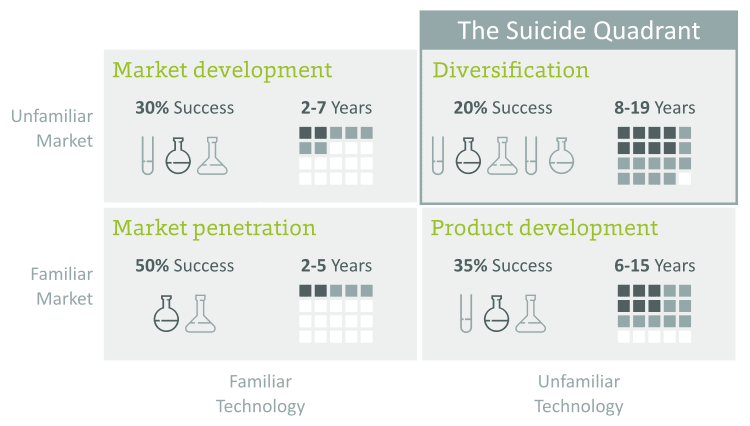How to de-risk your next chemical or material innovation for a fail-proof launch
Emerging chemical innovations are often encased in a chrysalis full of uncertainty. Whether they make it or wither away upon hatching, doesn’t have to be a mystery.
New chemicals and materials are brought to life through significant financial and laborious investments that fuel their development.
But, at SpecialChem, we often noticed that potential market risks aren’t demystified by chemical suppliers before their product breaks into the real world. And that’s what keeps your innovation from reaching its full commercial potential - a failure to de-risk.
Hyper-specialized innovation begs a greater need for de-risking
 The chemical industry is cut-throat. But now, the risk ‘dial’ is turned to an all-time high. It is not due to a massive rush of new products eyeing for commercial success - this was always there.
The chemical industry is cut-throat. But now, the risk ‘dial’ is turned to an all-time high. It is not due to a massive rush of new products eyeing for commercial success - this was always there.
What makes it riskier this time around is the need for hyper-specialized innovations targeting oversaturated markets.
When a new product is born to solve an exact problem, you are likely targeting a very narrow market. This is where things go awry for many chemical business developers - they try to fit a square peg in a round hole.
Let’s take the case of a customer who requested a custom material for their tank valve used in automotive. With sweat and a significant amount of money, your R&D team successfully develops a new grade matching those requirements. Fantastic!
With success comes big dreams. You quickly decide to launch this new product on the market to unleash its full business potential.
But after a year of marketing and sales investments, you and your team don’t reap the benefits. And most of the time, business developers can’t even know why.
By testing the market interest first, you would have realized how specific this customer’s request was. Other car manufacturers don’t use the same tank valve designs for example. May be a slightly different grade would have been successful.
Ejecting your innovation with your aim locked at the wrong market or at solving an illusory need is a recipe for disaster.
It is critical to identify the correct markets, along with their unmet needs, and to scan those unfamiliar grounds to spot potential threats carefully. Then you can arm your treasured innovation with effective survival weapons even before it takes its first breath.
Doing it pre-launch is important because your innovation is fragile unless it’s been de-risked.
Risk is ever-present but powerless when discovered
 We know what you are thinking - regardless of the innovation type or target market, risk is inevitable. Right?
We know what you are thinking - regardless of the innovation type or target market, risk is inevitable. Right?
It’s true that innovation and risk coexists. But it doesn’t have to stay in the shadows till later, and completely derail your innovation off the predicted path.
The more unfamiliar the market, the higher the risk and the lower the success rate. This can also be seen in the strategic planning tool, Ansoff matrix.
 The Ansoff Matrix applied to the innovation in chemicals and materials(1).
The Ansoff Matrix applied to the innovation in chemicals and materials(1).
This matrix categorizes product launches into four quadrants. And, you are right - while there is risk present in all of them, its amount varies.
When new innovations are released to new markets, only 1 in 5 achieves commercial success - that’s a statistic that does justice to its moniker ‘Suicide Quadrant’.
Even if you stay in your comfort zone, where familiar products are being offered to your current market, there is still only a 50% chance that you’d see success.
Risk-induced failure is a real epidemic. What fuels its spread is that companies wait to assess whether their innovation is a hit or a flop until after the launch.
They have no concrete idea about the obstacles that await them - or the extent of the reputational and financial repercussions a failed launch brings.
It’s like sinking your head in a fish tank full of piranha without looking at how many there are, and where.
Risk or Uncertainty: what is holding back your innovation?
 Every chemical innovator needs to be aware of two caustic variables that are looming around their precious innovation - risk and uncertainty.
Every chemical innovator needs to be aware of two caustic variables that are looming around their precious innovation - risk and uncertainty.
Many unknowingly mistake them to be the same. But there is a difference, and it shouldn’t be neglected.
Risks refer to known villains. You know how many there are, who they are, and the magnitude of damage each one is capable of. In other words, every facet of risk - including its very existence - is calculable.
Uncertainty is like walking through an unfamiliar alley blindfolded, and you have no idea what kind of menacing threat is lurking everywhere.
It’s a seductive idea to imagine your product as the damsel in distress, where you are the loveable, invincible hero who fights tooth and nail to keep it from falling into the clutches of evil traps.
But, it would help if you took the blindfold off first. To increase your chances of making it through unscathed, you map out the alley even before setting foot in it. You study the villains and create a route to skirt around them, while also equipping yourself with weapons to deal with unavoidable menaces.
Sadly, most companies are willingly donning a blindfold as they try to enter markets never encountered before.
They embrace uncertainty and give up their success to the fickle hands of luck.
This is self-sabotaging and contributes to why the diversification quadrant, a category brimming with opportunities, has been shunned away as the scary ‘suicide quadrant.’
There are abundant opportunities in areas like the USA, Europe, India and China. But every new market is bedded with its own set of risks, painted in strokes of regulatory compliance, competition, market size, market demand, cost inflation, consumer demographic, and more.
All of it culminates to birth its unique problems. Solutions to which might already exist in the market, albeit a weak one - it’s all a mystery that you have to unearth before you hand your own innovation on the silver platter.
FAQS: convert may-be risks into real facts
 Ok, you know identifying risks is important. And your colleagues can already think of potential risks.
Ok, you know identifying risks is important. And your colleagues can already think of potential risks.
So now, you can go to the whiteboard and start creating a strategy map, right?
Hold up! Not so fast.
While your company’s collective brain may be brimming with potential risks, you need to validate them as Facts.
What might look like risk in your mind may not exist in your target market in reality. And you don’t want to waste your time and resources making a mountain out of a molehill, do you?
Risks can be mapped out as FAQS:
- Facts - what you know to be true
- Assumptions - what you think is true
- Questions - what you know that you don’t know
- Surprises - what you don’t know even exists
Risks in the form of Assumptions, Questions, and Surprises need to be uncovered and converted into Facts much before the launch.
The red herrings need to be eliminated to get your hands on the ultimate list of validated risks.
Realize that when working in unfamiliar markets, you don’t have many Facts. You may have an idea of a list of risks in the form of Assumptions and Questions, but they haven’t been validated.
Your goal as an innovation manger or business developer should be to convert all your Questions, Assumptions into Facts, and discover the Surprises and convert them into Facts too.
After all, what you might think to be a python may be a coiled rope.
Don’t wait till launch. Ground yourself with certainty before development
 Billions of dollars and thousands of hours of labor go into developing chemical innovations. It is genuinely an intense game of blood, sweat, and grit.
Billions of dollars and thousands of hours of labor go into developing chemical innovations. It is genuinely an intense game of blood, sweat, and grit.
If perceived risks instead of factual risks drive all of this, then it is very likely that your innovation will fail.
Mining Facts through market exploration and validation early on is important so that your company isn’t wasting valuable limited resources diffusing a rock that you thought was a landmine.
But, to find Facts, you need unbiased and reliable data from partners who are a perfect representation of your target audience.
Gathering data on your own can affect the integrity of the results due to confirmation bias, respondent bias, and selection bias.
Since it is your own innovation, it can be challenging to conduct and analyze research through an impartial lens.
For example, you may pick and choose your favorite customers for focus interviews who might not be honest with their responses or be an accurate representation of your market.And this is precisely how your customers could be killing your chemical or material innovation.
With so much potential for bias flooding your market insight process, and limited access to getting an accurate sample size, you will never discover the Facts in a reasonable amount of time, cost and resources.
Use a third set of eyes to spot risks accurately
 Conducting your market insight on your own is theoretically possible but almost impractical in real conditions.
Conducting your market insight on your own is theoretically possible but almost impractical in real conditions.
Lack of resources and missing market connections will inevitably induce additional and substantial investments, plus prolong your time-to-market.
Relying on a third party, like SpecialChem’s Insight Solutions for your market insights, allows you to get your hands on valuable data —both quickly and cost-effectively.
You can explore new market opportunities and validate the demand for your innovation with an acute depiction from unfamiliar and familiar markets.
It is tempting and reassuring to involve your existing customers. But not all of them are honest in their responses if they know who you are. They might respond with sweet-nothings to please you - which is great for the ego but not so much for your innovation’s future.
With an external platform, you can stay anonymous while your innovation generates feedback from a much broader mix of chemical formulators and end-users. The results you get are an accurate, bias-free, representation of your market's needs and your innovation’s potential.
These insights accelerate the process of identifying Surprises and converting them, along with Assumptions and Questions, into Facts.
Risk is omnipresent, and it isn’t the same as uncertainty: Uncertainty is dangerous, while risks can be managed.
Once you have dissected the topography of the unfamiliar consumer base through market insights, and identified most of the risks before the launch, what’s left is to carve a safe path to your goal.
While uncertainty kills chemical innovation, managing risks makes your innovation better.
Once risks and uncertainties are known, the suicide element of the ‘suicide quadrant’ vanishes.
Sources
1 - Mc Kinsey - Chemical innovation: An investment for the ages